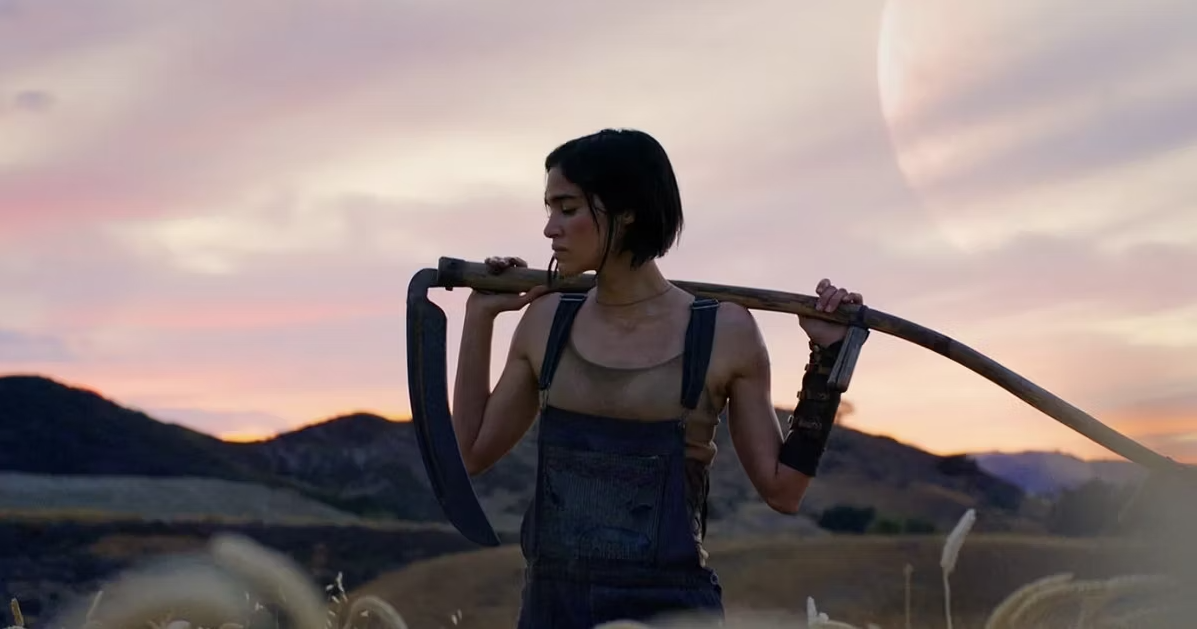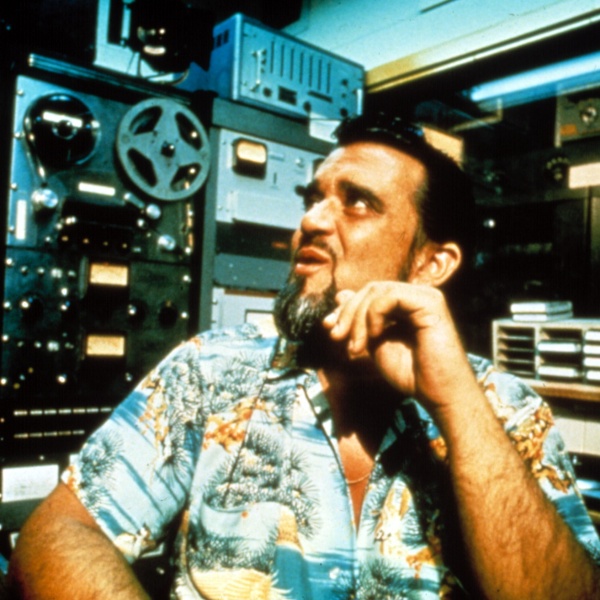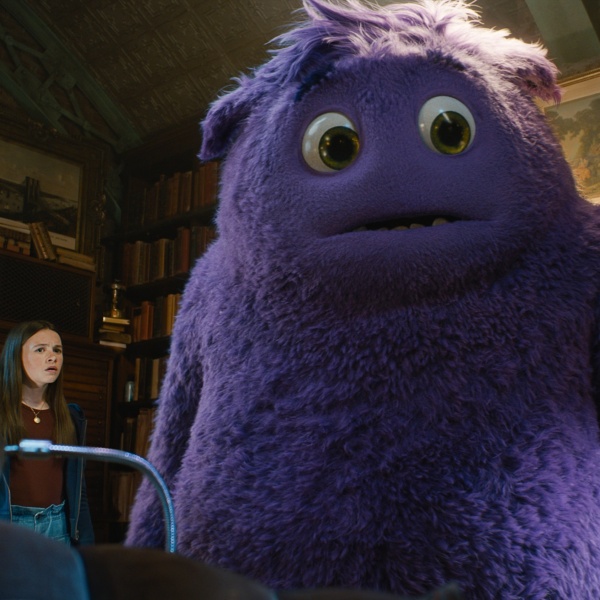From his fresh and inspired “The Dawn of the Dead” remake to his panel-for-panel adaptation of “300” and the fetishistic pastiche that he packed into his “Sucker Punch,” Zack Snyder has always been as much of a cover artist as he is an iconoclast. To his fans, Snyder is a sacred defender of the seriousness that Hollywood used to strip-mine from the geek culture it mulched into mass entertainment. To his critics, he’s blockbuster cinema’s first example of the A.I. image generator as auteur: Plug in some nerd-ass variables — zombies, Batman, sexual violence as character motivation, etc. — and watch him churn out a hollow but hopelessly self-impressed digital rendering of a favorite story or familiar trope that’s been sucked dry of its most basic lifeforce.
Snyder has moved away from intellectual property since partnering with Netflix for 2021’s “Army of the Dead,” and yet his latest streaming epic is so clumsily Frankensteined together from a pair of the most recognizable touchstones in film history that it doesn’t feel like a true original so much as a two-headed chimera without a single thought shared between them. Of course, the astronomical failure of Snyder’s latest and least interesting remix has nothing to do with its concept; “Sci-fi ‘Seven Samurai’” is a clever idea that’s been done before, and Snyder’s initial efforts to pitch that premise as a “Star Wars” spin-off was a rather galaxy-brained attempt to crossbreed a couple of cinema’s most iconic hybrids. No, the problem here is that, after Disney passed on the chance to integrate Snyder’s vision into the richest storytelling world that Western pop culture has ever created, he decided to set it in a universe of his own design.
“Rebel Moon — Part One: A Child of Fire” isn’t the first time that Snyder has ostensibly build a movie from scratch, but the difference in scale between the Hot Topic hell cabaret he dreamed up for “Sucker Punch” and the vast solar system of backstory required to support a franchisable new space opera is the difference between growing a Chia Pet in your childhood bedroom and going full Dr. Manhattan on Mars. While Akira Kurosawa lends Snyder a basic narrative structure (that he almost immediately warps beyond recognition), and George Lucas supplies him with the raw materials needed to reskin everybody’s favorite “Star Wars” characters into a hyper-derivative matrix of fascist space Nazis and double-crossing bounty hunters, Snyder lacks the skill to establish meaningful relationships between any of the five zillion different elements he’s borrowed from better films, and he lacks the imagination to inject even a single one of them with a lifeforce of its own.
The result is (the first half of) a singularly torturous slog that tries — and fails, and fails, and fails again for 134 minutes of agonizing tedium that are only interrupted by the occasional jolt of sadness for the wasted talent of everyone involved — to distill an iota of creative value from pre-existing images that never seemed worthless until Snyder tried to make them unique. It’s the cinematic equivalent of an NFT.
At least “Rebel Moon” does Netflix subscribers the courtesy of revealing how bad it is from the moment it begins. Choral wails over the studio logos give way to a dreadnought emerging from a vagina-shaped portal in deep space as Anthony Hopkins’ one-off narration lectures us ad nauseam about an evil Motherworld that’s trying to colonize the galaxy and wipe out every last rebel who might be hiding in its furthest reaches. In no universe should a story this trite require so long to set up, be so hard to follow, or involve so many nonsense words.
The lucky ones will bail before the footsoldiers of the Imperium first touch down upon the remote moon of Veldt, the rest of you are at risk of being exposed to Corey Stoll’s community leader Sindri — whose huge braided beard and tiny pork pie hat improbably split the difference between “God of War” and “Newsies” — and thus vulnerable to the misguided idea that it might be worth sitting through the rest of “Rebel Moon” just to see all the awfulness that Snyder inflicts on his cast. Make no mistake, that is the only reason to keep watching; Hopkins returns to voice an anti-violent robot who was programmed to blush, while Jena Malone’s one-scene appearance as a massive spider alien who compensates for her infertility by kidnapping children from a nearby cobalt mine is a first-ballot inductee to the Hall of Fame of Thankless Movie Performances (which is scheduled to open in the atrium of Netflix’s Los Angeles headquarters sometime in 2025). But watching at all is still the greatest mistake.
Backdropped by a massive Jupiter-like planet that makes all of the night scenes look as if they’ve been sand-blasted with a layer of digital Cheetos dust (an orange eyesore of an image that Snyder dotes upon as if staring at it for long enough might create the magic of Tatooine), Veldt is home to a simple community of luddite farmers who just want to work the land in peace. Unfortunately for them, basic grain is every bit as valuable to this hyper-futuristic universe full of crazy alien technology as it was to the famished peasants of 16th century Japan, and so the Motherland’s most sociopathic enforcer (Ed Skrein as Atticus Noble) murders Sindri as a preview of what he’ll do to the rest of the village if they haven’t harvested enough bushels to feed his army when they return in 10 weeks.
The naive villagers decide to keep up their end of the bargain in the foolish hopes that the Imperium soldiers will do the same, but mysterious newcomer Kora (Sofia Boutella) has seen enough bloodshed to know otherwise. She plans on fleeing, but is forced to adopt a new strategy after she kills a few Motherland grunts who are trying to gang-rape a local teenage girl (this is a Zack Snyder movie, after all). Kora’s new plan: Travel the galaxy and assemble a team of freelance warriors who will help the people of Veldt fight back against the overpowered space colonizers when they come back. How lucky for them that the Motherland army, despite having the power to travel through the universe at light speed and decimate planets at the bush of a button, lacks the basic communication technology required to see if the troops they left behind are still alive. They’re going to be in for quite a surprise when they return for that grain!

Anyway, Kora heads off into the great unknown, alone save for Gunnar (Michiel Huisman), the meek but strapping farmer who’s been fertilizing an obvious crush on this strange woman since the minute she landed on Veldt. We’re meant to believe that his feelings for Kora only deepen after she subjects him to several interminable flashbacks about her past as an orphan who was adopted by the Imperium’s most fearsome general, but there’s so little detail to these characters — and so few moments of meaningful overlap between them — that it’s hard to remember why they’re in the same movie, let alone that we’re supposed to be rooting for them to kiss. Kora’s only two identifiable characteristics are that she’s emotionally scarred and that she wears a sick cape. Sometimes she takes the cape off, and then she’s down to one. That may not be enough of a foundation to support the weight of the narrative universe that Netflix hopes to build on top of her (you typically need at least three characteristics to pull that off), but who knows.
Kora and Gunnar travel to a variety of increasingly bland locations, recruiting a new fighter into their party at each one. What should be a naturally satisfying narrative pattern is made unbearable because of the elements these episodic sequences have in common: Our heroes land on a hideous planet that’s devoid any palpable sense of place, stumble across whatever mix-and-match genre archetype they’re looking for, listen to their new friend monologue about the mind-numbing specifics of their anti-imperial motivation, and then engage in one of the worst fight sequences that Snyder has ever staged.
Take the one triggered by our heroes’ arrival at the outlaw bar where they meet a mercenary named Kai (Charlie Hunnam, easily the most charismatic non-cape screen presence in the movie). The bar is festooned with Japanese imagery for some reason, and the patrons include a deranged coterie of aliens who epitomize Snyder’s penchant for snazzy details that never cohere into anything bigger than their own discrete coolness (the “Starship Troopers” reject with a kink for telepathic enslavement is a real keeper). And you guys won’t believe this, but one of them — a queer-coded alien monster who looks like a human-pig hybrid covered in tumors — makes an overture of sexual violence towards Gunnar!
The resulting shootout is a poorly choreographed headache that’s speed-ramped to the point that you can actually see every opportunity that Snyder missed for a more satisfying choice. Even at a snail’s pace it can be impossible to tell what is happening, which might be preferable to the moments in which the weightlessness of the film’s blaster guns is on display in all its laser-tag-level PG-13 glory. The spatial geography in Kurosawa’s film was so legible that viewers knew an entire town like the back of their hands by the time the bandits came back to kill everyone in it; “Rebel Moon” can’t manage the same feat in the space of a single hallway.

And yet, the time dilation stuff is so egregious that your mind can wander away from the action in the span of a single kick. I found myself wondering about the reason for Snyder’s ongoing fascination with this technique, which started as a way of turning comic panels into motion paintings before it took on a life of its own in the director’s post-“300” work. Now serving as his own cinematographer, is Snyder so in love with his images that he wants us to savor them for as long as possible, or is it just that he’s so incapable of editing shots together into a sequence greater than the sum of their parts that he would rather focus our attention on the parts at the expense of their sum? Either way, the effect produced by all this speed-ramping is a fitting microcosm of a movie that feels like a million isolated storyboards without a single thing welding them together.
By all reason, the fights should only get better as Kora and Gunnar add new members to their team, and the dynamic between the mercenaries more complex, but the opposite proves true, as Snyder’s attention is pulled in so many directions at once that even the most basic dramatic questions start to become confounding (questions like: “where are we?” “who are they shooting at?” and “what if I was gravely wounded in the Vietnam War and this is all just an elaborate death dream I’m having in a medical tent circa 1971?”). I never would’ve thought that watching a cyborg swordmaster played by Bae Doona square off against a child-eating Jena Malone spider could be so deeply boring, but Snyder has always had a knack for sucking the fun out of things that must have seemed cool on paper.
I’d love to know more about the tentacle creature that slurps on Ed Skrein’s chest when he’s alone in his room at night, or why he — Skrein, not the tentacle creature — suddenly starts cosplaying as a member of Interpol — the band, not the international police force — in the second half of the movie. I’d love to know if Snyder was making some kind of perverse meta joke by giving Ray Fisher even less to do here than he was given in the theatrical cut of “Justice League,” and if his VFX team simply forgot to animate that one planet ruled by an adorable mollusk king (it’s just a lot of fog and some floating black slabs).
I assume that we’ll learn a little bit more about Djimon Hounsou’s drunken tactical genius when the Imperium descends upon the Veldt in the second part of “Rebel Moon,” and that Anthony Hopkins’ robot will explain why it’s wearing a pair of antlers in the last shots, but it’s also possible these unanswered questions are merely a pretext for another Snyder Cut — one that Netflix can use to squeeze a few more view hours out of a movie so insufferable that it should be measured in milliseconds. Whatever the case, it’s hard to be even morbidly curious, let alone excited, about any future iterations or installments of a franchise so determined to remix a million things you’ve seen before into one thing you’ll wish you’d never seen at all.
Grade: D-
“Rebel Moon — Part One: A Child of Fire” starts streaming on Netflix on Friday, December 22.





